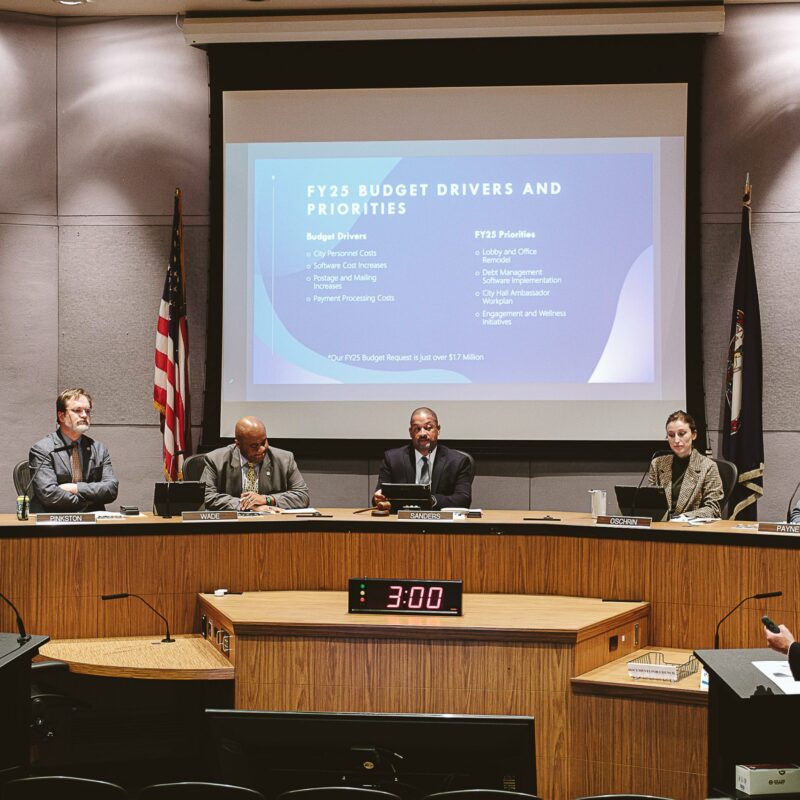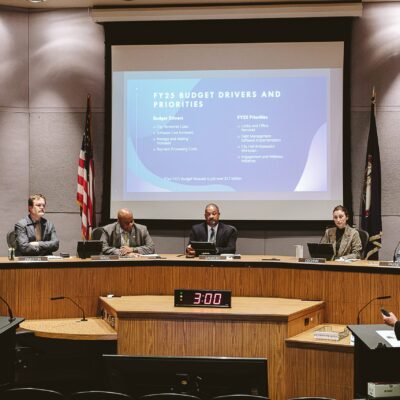music
The DJ, a tall, goateed man in a dark shirt and a Tampa Bay Lightning baseball cap, is still connecting the HDTV (high-definition television) to his PlayStation system as the 9pm start time for the first of the now-weekly Guitar Hero competition nights at Fellini’s #9, but by a few minutes after he’s ready to go. JacLynn Dunkle, the owner of Fellini’s, stands at his right, holding a black game controller shaped to look like a Fender Stratocaster, then passes the instrument to the evening’s first contestant, Laura.
 School of rock? Fellini’s #9 tuned up and turned on a new, weekly Guitar Hero competition night that proved videogames can’t beat the real thing, baby. |
Guitar Hero looms as the current franchise in interactive videogames, a music performance simulator crossed with “Simon Says” in which contestants use a miniature guitar with buttons for strings and a bar at the center of the body that they click and clack to make their virtual character (or avatar) strum. The latest installment, Guitar Hero III: Legends of Rock—the game onscreen tonight—reaped $115 million in sales during its first week on the gaming market.
While knowing an instrument doesn’t necessarily mean knowing a controller shaped like one, the game’s presentation—you pick a character and perform for a bunch of virtual headbangers in a luau-themed bar—re-creates the real-time experience of a live performance. I’m nursing a Newcastle and a notebook and shouting for someone to play “Barracuda” by Heart, hopeful that, if I do my part as a member of the crowd, the performers will do theirs.
And I’ll be honest: I want either button-mashing, thumb blister-popping virtuosity or a sad, eye-glazing and pathetic experience. I watch enough VH1 to know that rock stars are either selling hit albums or using booze like it was Miracle-Gro to cultivate their expanding guts. Like any rock fan, I want extremes, a slow ride or a stairway to heaven.
Plugged in and ready to go, Laura presents her back to the crowd that sits around the rectangular wooden bar and selects a song—Cream’s “Sunshine of Your Love,” Eric Clapton’s greatest take on the blues, his fuzz-draped Gibson guitar a thick-voiced, Janis Joplin-esque sound. A perfect rendition of the song is locked somewhere within the colored keys of Laura’s controller.
Laura stands with legs slightly spread as the TV displays a digital crowd and a faux Jimi Hendrix figure onstage; her fingers twitch slightly on a small bar at her controller’s guitar pick, and a metallic crunch sounds from the bar’s soundsystem. A metronome counts a few beats, then colored dots (representing the “notes” that Laura should punch on the corresponding “guitroller”) begin spilling down the screen.
| Video of Guitar Hero III. |
The sound is unglamorous, tin can clunks and metal wind chimes, as she misses every note, marring Clapton’s riffs. She pauses the game and announces, loud enough for the bar to hear. “This is HDTV. You have a lag. You need to fix this.”
For the first of at least 10 times, the game is recalibrated to eliminate a lag between the digital TV and the game system. Same countdown, same stance from Laura, but the crowd around the bar is attentive, all of them watching the screen, bar chatter minimal.
There is a brief cheer as Laura nails the opening bass riff of the song, and a louder one as the power chords and gooey lead guitar lines kick in. Doubters, myself included, realize that this Laura gal is some Eddie Van Halen-ish wunderkind. The screen repeatedly flashes notices like “50 Note Streak,” “100 Note Streak” and “Star Power Ready.” Not a note is missed, and so Clapton’s song is preserved flawlessly. Laura saves her high score and sits down.
The Guitar Hero song menu is slim—eight songs available tonight with the promise of more tunes next week, late ’70s to early ’90s numbers from the likes of Foghat to Social Distortion—and each one is played, with many of them repeated by the small number of players on-hand. But the crowds are occasionally harsh—both of them, virtual and real. The sharp soundsystem in Fellini’s makes the watering hole a great place to listen to music, but also makes for the true challenge Guitar Hero: If a player screws up a chord, the volume of Poison’s “Talk Dirty to Me” drops out entirely, replaced by the complaints of a fake audience that want a live concert, the groans of a real audience that want their makeshift jukebox to stop skipping, and that same metallic clank! clank! clank!
Two players go clam-handed following Laura’s performance, and Philip Green (who played Bob in the Live Arts production of American Buffalo), dressed in a black leather jacket, takes on Social Distortion’s “Story of My Life” three times consecutively, his hands barely missing the song’s rockabilly lead but distressing at least one old punk rocker at the bar that begins to plead for someone to “finish the fucking song.”
But some rockers deliver. A young woman in a black sweater and tight jeans makes good on “Story of My Life” (and is rewarded with an affectionate arm-pat from the punk) and a fair-skinned kid in a too-large shirt and a striped knit cap tears through Mountain’s “Mississippi Queen” while the DJ kickstarts a fog machine. It’s cheesy for a real concert, not to mention a fake one, but the fog (the ambrosia of rock musicians) seems like a reward for a hard-won tune. Both smile at the song’s end, the kid a bit sheepishly.
The problem is that I can’t decide what to watch, and I’m not enjoying much of what I see—profiles of performers emotionlessly tapping a controller, ignoring a living crowd for a TV set. Rock ’n’ roll extremes need to be seen to be experienced, but all I see is Laura, stepping up for another turn on the controller, Alice Cooper’s “School’s Out,” and facing away from the bar’s crowd towards her avatar, who faces outwards at his virtual audience. I watch the side of her face as she mouths along, mouth slightly upturned in a smile, barely audible.





